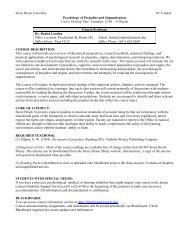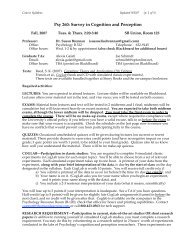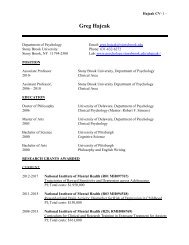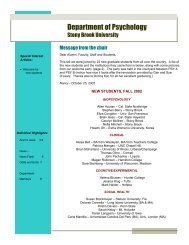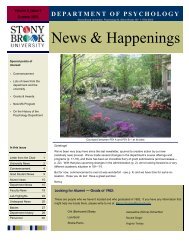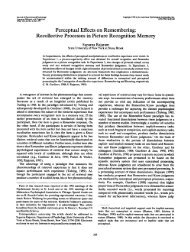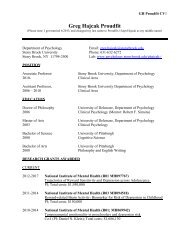Computer-Mediated Communication: A Cognitive Science Approach
Computer-Mediated Communication: A Cognitive Science Approach
Computer-Mediated Communication: A Cognitive Science Approach
You also want an ePaper? Increase the reach of your titles
YUMPU automatically turns print PDFs into web optimized ePapers that Google loves.
Article Number: LALI: 00861<br />
<strong>Computer</strong>-<strong>Mediated</strong> <strong>Communication</strong>: A <strong>Cognitive</strong> <strong>Science</strong> <strong>Approach</strong> 1<br />
a0005<br />
p0005<br />
p0010<br />
p0015<br />
<strong>Computer</strong>-<strong>Mediated</strong><br />
<strong>Communication</strong>: A <strong>Cognitive</strong><br />
<strong>Science</strong> <strong>Approach</strong><br />
S E Brennan and C B Lockridge, Stony Brook<br />
University (SUNY), Stony Brook, NY, USA<br />
ß 2006 Elsevier Ltd. All rights reserved.<br />
Human languages and the conventions for using them<br />
evolved with people interacting face-to-face. Likewise,<br />
face-to-face interaction is the key setting in<br />
which children acquire language. Despite these origins,<br />
more and more communication now takes place<br />
between people who are not copresent in the same<br />
space at the same time, via technologies such as e-<br />
mail, instant messaging, cell phones, voice mail, and<br />
videoconferencing. How do people adjust when communication<br />
is mediated? How is language processing<br />
affected? And how is conversation shaped by the<br />
medium in which it is conducted?<br />
Consider this example: Early one morning, Calion<br />
is typing an e-mail message to his wife Aisha, who will<br />
soon be in her office in the English Department across<br />
campus. If Calion wants Aisha to meet him later for a<br />
bite to eat, he cannot simply say, ‘‘Meet me for Indian<br />
after class.’’ Many things can go wrong. For instance,<br />
Calion needs to be confident that Aisha can receive the<br />
message (will she remember to plug her laptop into<br />
the campus network?), will be attentive enough to<br />
notice that a message has arrived (will she be too<br />
busy meeting with undergraduates to check e-mail?),<br />
will figure out what Calion intends (their common<br />
ground will likely enable her to figure out what he<br />
intends by ‘‘Indian’’ and ‘‘after class’’), and is willing<br />
and able to commit herself to the action he proposes<br />
(or will she have a meeting or other commitment at the<br />
time he’s proposing?). So after hitting the send key,<br />
Calion must await evidence that Aisha has received,<br />
understood, and committed to his invitation. For her<br />
part, Aisha doesn’t simply read Calion’s message and<br />
resolve to head out to the food court at the appropriate<br />
time; she sends an e-mail reply that gives evidence<br />
that she has received, understood, and accepted the<br />
invitation. Or if she needs to negotiate or clarify the<br />
plan, she may switch media and try to instant-message<br />
him; this will work only if they can both attend to their<br />
screens at the same time. If the expected e-mail response<br />
is not forthcoming soon enough, Calion may<br />
take the initiative to actively seek out evidence by<br />
calling Aisha on her cell phone.<br />
The point is that communication does not succeed<br />
automatically, just because two people speak<br />
the same language, possess the same cognitive<br />
architecture, and know the same things. Regardless<br />
of the mode of communication, people jointly construct<br />
meanings by engaging in an active process of<br />
‘grounding’, or seeking and providing evidence<br />
that they understand one another (Brennan, 1990,<br />
2004; Clark and Brennan, 1991; Clark and Schaefer,<br />
1989; Clark and Wilkes-Gibbs, 1986; Schober and<br />
Clark, 1989). Contributions to conversations are coordinated<br />
in two phases: a presentation phase and an<br />
acceptance phase (Clark and Schaefer, 1989). As<br />
Calion’s invitation illustrates, an utterance does not<br />
count as an actual contribution to a conversation (nor<br />
as part of the interlocutors’ common ground) until its<br />
acceptance phase is complete. After (or depending on<br />
the modality of communication, even while) one person<br />
presents an utterance, the addressee provides evidence<br />
of attention, understanding, and uptake. This<br />
evidence may be implicit, in the form of continued eye<br />
contact or a relevant next turn (as when an answer<br />
follows a question), or explicit, in the form of a<br />
rephrasing, a request for clarification, or a modification<br />
of what came before (Clark and Schaefer, 1989).<br />
Both speaker and addressee take responsibility for<br />
seeking and providing evidence; often who takes the<br />
initiative at any given moment depends on who can<br />
do so more easily (Brennan, 1990). In this way, interlocutors<br />
in a collaborative task adjust their individual<br />
effort in order to minimize the effort they expend<br />
jointly, in order to reach a grounding criterion, or<br />
degree of certainty that they understand one another<br />
sufficiently well for current purposes (Clark and<br />
Wilkes-Gibbs, 1986).<br />
In the rest of this article, we will briefly present<br />
some robust findings about mediated communication<br />
and discuss them in the context of the grounding<br />
framework. The grounding framework conceptualizes<br />
mediated communication as a coordinated activity<br />
constrained by costs and affordances (Clark and<br />
Brennan, 1991). This framework is compatible with<br />
both experimental and descriptive findings about<br />
communication (whether electronic or face-to-face)<br />
and can be used to predict and explain how communication<br />
media shape language use.<br />
FIRST PROOF<br />
Basic Findings About <strong>Mediated</strong><br />
<strong>Communication</strong>: Speech and Visual<br />
Evidence<br />
The richness associated with face-to-face conversation<br />
diminishes when communication goes electronic:<br />
for instance, prosody is absent when text is the currency<br />
of exchange rather than speech; spontaneous<br />
AU:1<br />
p0020<br />
s0005<br />
p0025
Article Number: LALI: 00861<br />
2 <strong>Computer</strong>-<strong>Mediated</strong> <strong>Communication</strong>: A <strong>Cognitive</strong> <strong>Science</strong> <strong>Approach</strong><br />
AU:2<br />
p0030<br />
p0035<br />
p0040<br />
facial expressions and gestures are lost when an interlocutor<br />
can’t be seen; and conversational turns grow<br />
longer with voice mail or e-mail messages than with<br />
media that support more fine-grained interaction,<br />
such as electronic chat or telephone conversations.<br />
Yet perhaps surprisingly, people are able to communicate<br />
quite clearly and easily over a wide variety<br />
of media, including those with relatively low bandwidth<br />
(e.g., text-based media); in fact, cognitive tasks<br />
tend to be accomplished just as well over lower-bandwidth<br />
media as face-to-face (for a comprehensive<br />
review, see Whittaker, 2002). Despite the common<br />
expectation that the more similar a medium is to<br />
face-to-face communication, the better communication<br />
should be, study after study has failed to confirm<br />
this ‘bandwidth hypothesis’ (Brennan, 1990, 1994;<br />
Brennan and Lockridge, 2004; Karsenty, 1999;<br />
Ohaeri, 1998; Whittaker, 2002). Clearly, more bandwidth<br />
is not necessarily better. In fact, mediated communication<br />
sometimes offers tangible advantages<br />
over face-to-face conversation, especially when it is<br />
of value to be able to edit utterances, review them, or<br />
save them as a paper trail; when it is useful to broadcast<br />
them to many addressees at once; or when interlocutors’<br />
schedules prevent them from attending to a<br />
message at the same time.<br />
Some studies have documented media-based differences<br />
in efficiency among task-oriented conversations<br />
(higher efficiency is when the same task is<br />
accomplished just as well in less time or with fewer<br />
words). In comparisons of different configurations<br />
of speech, handwriting, teletyping, and video, Chapanis<br />
and colleagues found early on that remote<br />
communication is much less efficient without speech;<br />
the only way to substantially improve a medium’s<br />
efficiency is to add a voice channel (Chapanis<br />
et al., 1972; Chapanis et al., 1977; Ochsman and<br />
Chapanis, 1974). The ability to coordinate using<br />
speech typically makes a task more efficient by a<br />
factor of two or more.<br />
Yet adding a video channel to a medium that already<br />
includes speech may do nothing to improve<br />
either performance or efficiency (Chapanis et al.,<br />
1972; Chapanis et al., 1977; Ochsman and Chapanis,<br />
1974; Whittaker, 2002; Williams, 1977). Of course,<br />
this depends on what visual information is transmitted:<br />
For cognitive or physical tasks where the focus is<br />
on the task activity, there are few if any benefits to<br />
seeing a partner’s face (Fish et al., 1993; Gaver et al.,<br />
1993; Whittaker, 1995, 2002), despite repeated<br />
attempts by telephone companies and teleconferencing<br />
researchers to supply disembodied talking heads<br />
along with people’s voices. (Seeing the face of a<br />
remote interlocutor can, however, have effects<br />
upon interpersonal social judgments, affiliation, or<br />
adversarial situations involving negotiation; see<br />
Whittaker, 2002 for a review). Visual information<br />
other than faces, such as views of the objects or task<br />
under discussion, can be very useful in task-directed<br />
communication (Anderson et al., 2000; Brennan and<br />
Lockridge, 2004; Clark and Krych, 2004; Kraut et al.,<br />
2002; Whittaker, 1995, 2002). The impact of a particular<br />
kind of visual information can be explained by<br />
the role it plays in grounding.<br />
Consider the task of giving someone driving directions.<br />
This is easiest when both partners can see and<br />
point at the same map. In one study of remote communication<br />
(Brennan, 1990, 2004), two partners had<br />
the same map displayed on their screens and could<br />
speak freely to one another. One, the director, knew<br />
the target location, and directed the other, a matcher,<br />
to move his car icon to the target. Half the time the<br />
director could see on her map where the matcher’s car<br />
was, and half the time she could not (the situation<br />
was asymmetrical; the matcher saw his own car icon<br />
in both conditions). When directors had visual evidence<br />
about matchers’ understanding, matchers quite<br />
literally came to use icon motion to replace their turns<br />
in the conversation. And directors could quickly tell<br />
when matchers understood where the target location<br />
was, so directors took responsibility for deciding<br />
when it was time to move on to the next trial. In trials<br />
without such evidence, directors waited for matchers<br />
to tell them when they understood well enough to<br />
move on. Trials with visual evidence also took less<br />
than half as long as those without, because pairs<br />
could ground in parallel; that is, while the director<br />
presented a description, the partner conducted the<br />
acceptance phase simultaneously by silently moving<br />
his icon (see Figure 1). Without visual evidence (see<br />
Figure 2), he had to give verbal evidence, speaking<br />
after the director’s description, which made the granularity<br />
of interaction much larger.<br />
Grounding in <strong>Mediated</strong> <strong>Communication</strong><br />
FIRST PROOF<br />
In mediated communication, interlocutors typically<br />
inhabit different times and/or different places, so<br />
some aspects of coordination can be more difficult<br />
than in face-to-face conversation, particularly if people<br />
are limited to a medium that does not facilitate<br />
grounding or if techniques for grounding within the<br />
medium are unknown. Table 1, adapted from Clark<br />
and Brennan (1991), compares key affordances of<br />
face-to-face conversation with those of four other<br />
communication media.<br />
Grounding in communication can be decomposed<br />
into various sub-tasks bearing distinct costs (Clark<br />
and Brennan, 1991; Brennan, 1998), with the idea<br />
that people must adapt techniques for grounding to<br />
p0045<br />
s0010<br />
p0050<br />
p0055
Article Number: LALI: 00861<br />
<strong>Computer</strong>-<strong>Mediated</strong> <strong>Communication</strong>: A <strong>Cognitive</strong> <strong>Science</strong> <strong>Approach</strong> 3<br />
f0005 Figure 1 In this example, D can see M’s icon, which provides<br />
immediate visual evidence about how M understands D’s description.<br />
The exchange occurs as M moves his icon toward the<br />
target location described by D. D takes the initiative to propose<br />
that M has the right location using a deictic cue (‘‘right there’’)<br />
after only 6 seconds. The graph shows the convergence of icon to<br />
target over time, with the point at which the icon reaches the<br />
target marked on the graph by an arrow.<br />
f0010 Figure 2 In this example, D cannot see M’s icon and so grounding<br />
depends on the verbal evidence of understanding sought by<br />
D and provided by M. After the icon reaches the correct location<br />
there follows a lengthy period of grounding before they reach<br />
their grounding criteria and can conclude that they understand<br />
one another.<br />
the affordances and constraints of the current medium<br />
in order to meet these costs. Sub-tasks that incur<br />
grounding costs include getting a partner’s attention<br />
in order to initiate communication (startup costs);<br />
producing a presentation by speaking or typing or in<br />
some other manner (production costs); timing the<br />
placement of feedback (asynchrony costs) or of a<br />
conversational turn (speaker-change costs); pointing,<br />
demonstrating, or gesturing in order to refer or clarify<br />
content (display costs); awaiting, reading, or listening<br />
to a partner’s utterance (reception costs); monitoring<br />
the partner’s focus of attention and, if the dialog<br />
is task-oriented, any relevant activities or tangible<br />
products that make up the task (monitoring costs),<br />
preventing misunderstandings or repairing errors<br />
caused by self or partner (repair costs), and maintaining<br />
politeness (face-management costs) [based on<br />
Clark and Brennan, 1991 and Brennan and Ohaeri,<br />
1999]. Discussing a few of these costs will help show<br />
how grounding shapes behavior.<br />
Startup and monitoring costs are low for people<br />
who are physically copresent because they can easily<br />
monitor what a partner is doing, assess when the time<br />
is right for an interruption, and initiate a conversation<br />
by speaking to get the partner’s attention (for review<br />
of physical proximity effects, see Kraut et al., 2002).<br />
Startup is more costly for a video conference, since<br />
participants must arrange to be present in appropriately<br />
equipped facilities at the same time. Starting up<br />
a telephone call is unpredictable on a landline, as<br />
people are often away from such telephones; but<br />
with proliferating cell phones, calls find addressees<br />
regardless of their locations and so startup costs are<br />
somewhat lower.<br />
Production costs are typically higher for text than<br />
for speech because most people find it harder to type<br />
than to speak, so typed utterances tend to be shorter<br />
than spoken utterances. In one study, people were<br />
more likely to sacrifice politeness when typing than<br />
when speaking when it took more words to frame a<br />
polite utterance (e.g., inviting a partner’s input using<br />
hedges), but not when it took the same number of<br />
words to be polite (e.g., inviting the partner’s input<br />
with questions); moreover, individuals with faster<br />
typing speeds used more politeness devices per 100<br />
words than those who typed slowly (Brennan and<br />
Ohaeri, 1999). This finding demonstrates that people<br />
who communicate remotely do not actually become<br />
depersonalized or cease to care about politeness (as<br />
some social psychological theories have suggested),<br />
but that when they must struggle to meet production<br />
costs they do this at the expense of something else,<br />
such as face-management. It also illustrates that<br />
grounding costs are not independent of one another;<br />
often one cost must be traded off against another, and<br />
such trade-offs are made differently in different<br />
media.<br />
As another example, consider repair costs: When<br />
communication is cotemporal, such as with voice,<br />
text-based chat, and instant messaging, the grain of<br />
interaction is small, and turns tend to be shorter, less<br />
formal, and more numerous than in larger-grained<br />
text-based media (such as letters or e-mail). So any<br />
errors or misunderstandings can be addressed quickly,<br />
and repair costs are relatively low (more so for<br />
speech than for text, since production costs are higher<br />
for text).<br />
FIRST PROOF<br />
p0060<br />
p0065<br />
p0070
Article Number: LALI: 00861<br />
4 <strong>Computer</strong>-<strong>Mediated</strong> <strong>Communication</strong>: A <strong>Cognitive</strong> <strong>Science</strong> <strong>Approach</strong><br />
t0005 Table 1 Affordances of <strong>Communication</strong> Media<br />
Media<br />
Affordances of Media<br />
Faceto-face<br />
Video<br />
conference<br />
Telephone<br />
Instant<br />
messaging or<br />
chat<br />
E-<br />
mail<br />
p0075<br />
(1) Physical co-presence: Participants share a physical environment,<br />
þþ ??<br />
including a view of what each is doing and looking at.<br />
(2) Visibility: One participant sees another, but not necessarily what the other þþ þ<br />
is doing or looking at.<br />
(3) Audibility: One participant can hear another. þþ þþ þþ<br />
(4) Cotemporality: Messages are received without delay (close to the time þþ ?? þþ ??<br />
that they are produced and directed at addressees), permitting finegrained<br />
interactivity.<br />
(5) Simultaneity: Participants can send and receive messages at the same þþ ?? þþ ??<br />
time, allowing communication in parallel.<br />
(6) Sequentiality: Participants take turns in an orderly fashion in a single þþ þþ þþ<br />
conversation at a time; one turn’s relevance to another is signaled by<br />
adjacency.<br />
(7) Reviewability: Messages do not fade over time. þþ þþ<br />
(8) Revisability: Messages can be revised before being sent. þþ þþ<br />
a<br />
Present in a particular medium: þþ; present to a limited extent: þ; present in some systems: ??; absent: . Physical co-presence (1),<br />
the hallmark of face-to-face communication, nearly always includes affordances (2) through (5).<br />
Adapted from Clark & Brennan, 1991.<br />
In closing, the grounding framework is a usefulvantage<br />
point from which to view, understand, and<br />
predict the effects of new media upon communication.<br />
The abundance and portability of new communication<br />
programs and devices (PDAs, added cell<br />
phone functionality such as digital photography,<br />
more extensive wireless networks, unobtrusive<br />
methods for eye-tracking, multimedia Internet content,<br />
etc.) will continue to make it even easier for<br />
mediaphiles to switch mid-conversation from one<br />
medium to another, as in our opening example of<br />
Calion’s e-mail invitation to Aisha. Recently the New<br />
York Times chronicled a man and his BlackBerry (a<br />
portable wireless device for e-mail and instant messaging):<br />
‘‘He once saw a romantic interest walk into a<br />
bar and immediately called her on her cell phone. ‘I<br />
saw her look at the phone and put me right to voice<br />
mail,’ he said, still indignant. But then he sent her a<br />
BlackBerry message, which made her laugh and<br />
prompted her to walk over and find him.’’ The ability<br />
to spontaneously switch media within the same conversation<br />
enables increasingly flexible and innovative<br />
techniques for grounding.<br />
See also: <strong>Computer</strong>-mediated communication (00703);<br />
Context and common ground (01088); Dialogue and Interaction<br />
(00792); E-mail, Internet, Chatroom talk, pragmatics<br />
of (00377); Multimodal Interaction with computers<br />
(04362); Pauses and Hesitations: A psycholinguistic approach<br />
(00796); Psycholinguistics: Overview (00788).<br />
Bibliography<br />
Anderson A H, Smallwood L & MacDonald R (2000).<br />
‘Video data and video links in mediated communication:<br />
What do users value?’ International Journal of Human-<br />
<strong>Computer</strong> Studies 52, 165–187.<br />
Brennan S E (1990). Seeking and providing evidence for<br />
mutual understanding.’ Unpublished doctoral dissertation,<br />
Stanford University, Stanford, CA.<br />
Brennan S E (1998). ‘The grounding problem in conversation<br />
with and through computers.’ In Fussell S R & Kreuz<br />
R J (eds.) Social and cognitive psychological approaches<br />
to interpersonal communication. Hillsdale, NJ: Erlbaum.<br />
201–225.<br />
Brennan S E (2004). ‘How conversation is shaped by visual<br />
and spoken evidence.’ In Trueswell J & Tanenhaus M<br />
(eds.) World situated language use: Psycholinguistic, linguistic,<br />
and computational perspectives on bridging the<br />
product and action traditions. Cambridge, MA: MIT<br />
Press.<br />
Brennan S E & Lockridge C B (2004). ‘Monitoring an<br />
addressee’s visual attention: Effects of visual co-presence<br />
on referring in conversation.’ Unpublished manuscript.<br />
Brennan S E & Ohaeri J O (1999). ‘Why do electronic<br />
conversations seem less polite? The costs and benefits of<br />
hedging.’ Proceedings, International Joint Conference on<br />
Work Activities, Coordination, and Collaboration<br />
(WACC ’99). San Francisco, CA: ACM. 227–235.<br />
Chapanis A, Ochsman R & Parrish R (1972). ‘Studies<br />
in interactive communication I: The effects of four<br />
communication modes on the behavior of teams<br />
during cooperative problem solving.’ Human Factors<br />
14, 487–509.<br />
FIRST PROOF
Article Number: LALI: 00861<br />
<strong>Computer</strong>-<strong>Mediated</strong> <strong>Communication</strong>: A <strong>Cognitive</strong> <strong>Science</strong> <strong>Approach</strong> 5<br />
AU:3<br />
AU:4<br />
Chapanis A, Ochsman R & Parrish R (1977). ‘Studies in<br />
interactive communication II: The effects of four communication<br />
modes on the linguistic performance of teams<br />
during cooperative problem solving.’ Human Factors 19,<br />
487–509.<br />
Clark H H & Brennan S E (1991). ‘Grounding in communication.’<br />
In Resnick L B, Levine J & Teasley S D (eds.)<br />
Perspectives on socially shared cognition. Washington,<br />
DC: APA. 127–149 [Reprinted in Baecker R M (ed.)<br />
Groupware and computer-supported cooperative work:<br />
Assisting human-human collaboration. San Mateo, CA:<br />
Morgan Kaufman. 222–233.].<br />
Clark & Krych (2004). ‘Speaking while monitoring addressees<br />
for understanding.’ Journal of Memory and Language<br />
50, 62–81.<br />
Clark H H & Schaefer E F (1989). ‘Contributing to discourse.’<br />
<strong>Cognitive</strong> <strong>Science</strong> 13, 259–294.<br />
Clark H H & Wilkes-Gibbs D (1986). ‘Referring as a<br />
collaborative process.’ Cognition 22, 1–39.<br />
Fish R, Kraut R & Root R (1993). ‘Video as a technology<br />
for informal communication.’ <strong>Communication</strong>s of the<br />
ACM 36, 48–61.<br />
Gaver W, Sellen A & Heath C (1993). ‘One is not enough:<br />
Multiple views in a media space.’ In Proceedings of CHI<br />
’93: Human Factors in Computing Systems. New York:<br />
ACM Press. 335–341.<br />
Hanna J E & Brennan S E (2004). ‘Using a speaker’s eyegaze<br />
during comprehension: A cue both rapid and flexible.’<br />
Abstract, 17th Annual CUNY Conference on<br />
Human Sentence Processing. MD: College Park.<br />
Karsenty L (1999). ‘Cooperative work and shared context:<br />
An empirical study of comprehension problems in sideby-side<br />
and remote help dialogues. Human-<strong>Computer</strong><br />
Interaction 14(3), 283–315.<br />
Kraut R E, Fussell S R & Brennan S E (2002). ‘Understanding<br />
effects of proximity on collaboration: Implications<br />
for technologies to support remote collaborative work.’<br />
In Hinds P & Kiesler S (eds.) Distributed work. Cambridge,<br />
MA: MIT Press. 137–162.<br />
Lee J (2004). ‘A BlackBerry throbs, and a wonk has a date.’<br />
New York Times Sunday Styles, Section 9, May 30. 1–2.<br />
Ochsman R B & Chapanis A (1974). ‘The effects of 10<br />
communication modes on the behavior of teams during<br />
cooperative problem-solving.’ International Journal of<br />
Man–Machine Studies 6, 579–619.<br />
Ohaeri J O (1998). ‘Group processes and the collaborative<br />
remembering of stories.’ Unpublished doctoral dissertation,<br />
State University of New York at Stony Brook.<br />
Whittaker S (1995). ‘Rethinking video as a technology for<br />
interpersonal communications: theory and design implications.’<br />
International Journal of Man-Machine Studies<br />
42, 501–529.<br />
Whittaker S (2002). ‘Theories and methods in mediated<br />
communication.’ In Graesser A, Gernsbacher M &<br />
Goldman S (eds.) The Handbook of Discourse Processes.<br />
Hillsdale, NJ: Erlbaum. 243–286.<br />
Whittaker S J, Brennan S E & Clark H H (1991). ‘Coordinating<br />
activity: An analysis of interaction in computersupported<br />
cooperative work.’ In Proceedings of CHI ‘91:<br />
Human Factors in Computing Systems. New Orleans,<br />
LA: Addison-Wesley. 361–367.<br />
Williams E (1977). Experimental comparisons of face-toface<br />
and mediated communication. Psychological Bulletin<br />
16, 963–976.<br />
FIRST PROOF
Article Number: LALI: 00861<br />
Author Query Form<br />
Book: Encyclopedia of Language and Linguistics<br />
Article No.: 00861<br />
Dear Author,<br />
During the preparation of your manuscript for typesetting some questions have arisen. These are listed below. Please check your<br />
typeset proof carefully and mark any corrections in the margin of the proof or compile them as a separate list. Your responses to<br />
these questions should be returned within seven days, by email, to Dr Jon Oberlander, email: J.Oberlander@ed.ac.uk, and<br />
copied to MRW Production, email: lali_proofs@elsevier.com<br />
Query Details Required Author’s response<br />
AU1<br />
AU2<br />
AU3<br />
AU4<br />
AU5<br />
AU6<br />
Schober and Clark is not in ref list; please supply full<br />
reference.<br />
Brennan 1994 is not in ref list; please supply full<br />
reference.<br />
Please supply year of publication of reprint.<br />
Please supply author initial(s).<br />
Please provide descriptive text for the sound clips.<br />
Please provide photograph for author biography.
Article Number: LALI: 00861<br />
Non-Print Items<br />
Abstract:<br />
In successful communication, two people converge on the belief that they are talking about the same thing. Now that<br />
much communication takes place over electronic media that bridge time and space, many activities formerly<br />
conducted face-to-face are no longer so. We present a theoretical framework for conceptualizing conversation as a<br />
collaborative activity, that of ‘grounding’ (Clark and Brennan, 1991). This framework is consistent with experimental<br />
and descriptive findings about mediated communication, particularly for task-oriented dialogues, and is useful for<br />
explaining and predicting how a medium shapes communication.<br />
AU:6<br />
Biography:<br />
Susan Brennan holds joint appointments at Stony Brook University in Psychology and <strong>Computer</strong> <strong>Science</strong>. Her Ph.D.<br />
is from Stanford University and her M.S. is from MIT’s Architecture Machine Group (the Media Lab), where she<br />
worked on computer-generated caricatures and teleconferencing interfaces. She has conducted research on natural<br />
language processing and human-computer interaction at Atari, Apple, and HP Labs. She currently uses behavioral<br />
and eye-tracking techniques to study the interpretation, production, and adaptation of spontaneous speech in<br />
interactive settings, including how interlocutors converge in perspective, lexical choices, and dialect. She serves<br />
as consulting editor of Psychological <strong>Science</strong>; previously she served as associate editor of Discourse Processes and<br />
consulting editor of Computational Linguistics.<br />
Biography:<br />
Calion B. Lockridge received his B.A. from Langston University and his M.A. from Stony Brook University, where he is<br />
currently a Ph.D. student. He previously held a W. Burghardt Turner Fellowship and is currently an NRSA Fellow,<br />
supported by the National Institutes of Health’s Institute for Deafness and Other <strong>Communication</strong> Disorders (NIDCD).<br />
His research interests include referential communication, the impact of individual differences in working memory span<br />
on language use in conversation, and the effects of visual copresence on communication.<br />
Keywords: Multimedia, E-mail, Face-to-face conversation, Dialogue, Interaction, Coordination, Speaking, Feedback,<br />
Grounding, Common ground, Repair<br />
Multi Media Component:<br />
AU:5<br />
Sound Clip 1 Given by Susan Brennan of audio data from Brennan, 1990.<br />
Sound Clip 2 Given by Susan Brennan of audio data from Brennan, 1990.<br />
Author Contact Information:<br />
Susan Brennan<br />
Department of Psychology<br />
State University of New York at Stony Brook<br />
Stony Brook, NY 11794-2500<br />
New York<br />
USA<br />
susan.brennan@sunysb.edu



